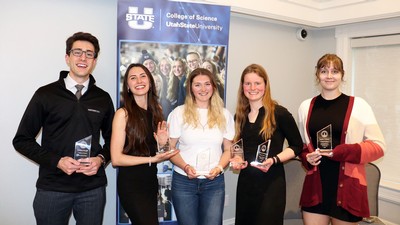Ear to the Ground: USU Industrial Hygienists Perform Noise Assessment for Army ROTC Cannon Crew
For time-honored Aggie tradition, Jim Bridger Battalion cadets seek occupational safety recommendations from USU public health scholars. USU leads the charge with findings that will benefit the Army ROTC's multi-state 5th 'Apache' Brigade.
By Mary-Ann Muffoletto |
Video by Taylor Emerson, Digital Journalist, University Marketing & Communications
Firing the cannon by Utah State University’s Army ROTC Jim Bridger Battalion is a beloved, time-honored tradition at Aggie home football games. In exciting pageantry and delight to Aggie fans, cadets shoot off a round from a 75-mm howitzer at kick-off and after each USU touchdown and field goal.
“It’s an important community-building ritual Aggie fans look forward to,” says Army ROTC cadet Alexa Dean, a cannon crew commander and senior psychology and sociology major. “On a rare occasion when the cannon was out of commission, we received concerned calls. People really missed it.”
For Dean and fellow cadet Collin Crowson, serving on the cannon crew is a privilege as well as “a fun and exciting activity.”
“With a demanding academic schedule and ROTC responsibilities, serving on the crew is a way I can show my school spirit,” says Crowson, a sophomore international studies major. “I really enjoy the camaraderie with my fellow cadets and the energy from the home team crowd.”
At the Nov. 11, 2023 Veterans Day game versus Nevada, the Aggie Football Team gave the cannon crew multiple opportunities for artillery fire as the Aggies surged ahead of their Mountain West rivals in the second quarter and kept the momentum going to a thrilling 41-24 victory.
The crisp fall day also provided an ideal opportunity for the cadets to collaborate with USU industrial hygiene students, invited by the battalion, to conduct a noise assessment of the exuberant cannonade.
“We’re training to be leaders, and a responsibility of leaders is to look out for the physical and mental well-being of those under our command,” Crowson says.
Dean says cannon crew members follow strict safety protocols, including use of hearing protection, during cannon firings. Still, enlisting expertise from fellow USU students seemed a proactive step and an opportunity to participate in the kind of safety and occupational health management tasks cadets will repeatedly encounter in their future careers as army officers.
“We lead by example, and seeking the best advice and tools, along with collaborating with experts, is a way to demonstrate forward-thinking management,” she says.
The industrial hygiene students, whose program is among the Department of Biology’s Public Health degree offerings and one of only four ABET-accredited undergraduate IH programs in the nation, jumped at the opportunity to participate in a real-world occupational health challenge.
“We’re called on to perform noise assessments for local industries as part of our academic program — drilling, grinding, hammering and all kinds of noise from machinery and heavy equipment,” says Spencer Fairbanks, who joined undergraduate classmates Tannon Merrill, Emma Sharp, Hunter Esplin and Annalyn Jensen on the project. “The cannon noise assessment is one of our more unique requests.”
To prepare for game day noise sampling, the industrial hygienists assembled three kinds of assessment tools: clip-on dosimeters that each cannon crew member would wear on their shoulder to measure personal noise exposures, a sound level meter and a calibration instrument.
“The dosimeters allowed us to collect data on each person’s noise level exposure, the sound level meter allowed us to measure the overall sound levels of a game day stadium and the calibration instrument ensured the accuracy of our measurements,” Sharp says.
The industrial hygiene sampling crew also wore dosimeters during the game day measurements, to collect data on noise levels throughout the stadium.
“We needed to determine the different levels of exposure and map peak noise levels around the cannon,” Esplin says.
A peak noise level map the industrial hygienists compiled revealed the cadets performing racking and reloading tasks on the left side of cannon received the highest noise level exposures. Cadets and others standing behind the cannon received lower exposures, but the noise levels still exceeded OSHA limits, along with the stricter Department of Defense safety limits.
“We also noted the stadium’s concrete wall behind the cannon caused each firing to reverberate, which accentuated the noise of each blast,” Sharp says.
In a 10-page report, featuring an additional 20 pages of collected dosimetry data, the industrial hygienists wrote the cadets’ existing ear plugs, if worn correctly, provided adequate protection from the game day cannon’s noise exposures. However, the scientists recommended the cadets switch to earmuffs, which would allow the cadets to quickly don and doff the noise protection as needed.
“During a dynamic football game, cadets scramble to react and fire the cannon as points are made, and it’s difficult to put ear plugs in quickly,” Merrill says. “It takes some time and effort to roll the ear plug with one hand and to use your other hand to pull your ear back to straighten the ear canal to get the plug properly inserted. Then, you have to repeat the process for the other ear. In order to provide full protection, ear plugs must also expand in the ear canal, which takes about 15 seconds. With earmuffs, you can simply wear them around your neck, rapidly place them over your ears and have full protection in seconds. We think the earmuffs are a more convenient, comfortable and effective solution.”
Occupational hearing loss, Sharp explains, is one of the most common work-related illnesses in the United States.
“Hearing loss can happen all at once, but in most cases it’s a cumulative process that happens a little at a time over years of exposure, before a worker even notices it,” she says. “It can be a debilitating problem that negatively impacts a person’s quality of life. Yet, in most cases, it’s preventable with good protective practices.”
In their report, the industrial hygienists further recommended regular training of cadets in the importance and proper use of hearing protection, along with implementation of a choice of specific models of professional-grade safety earmuffs. And those recommendations, says Major Kelly Kimber, battalion commander and head of USU’s Military Science Department, are exactly the guidelines cadets will follow from this point forward.
“The Army takes safety very seriously,” Kimber says. “We’ve secured funding to provide the earmuffs and training, and we’re grateful to the USU industrial hygiene team for providing this vital assessment.”
He adds not only will the USU battalion benefit from the assessment, but the multi-university 5th Brigade “Apache” Army ROTC, which includes university battalions from Utah and surrounding states, and of which Utah State is a part, will also follow, and benefit from, the USU scholars’ recommendations.
“Not all of our fellow battalions have cannon crews, but all are exposed to high noise levels in one form or another,” Kimber says. “Utah State is leading the charge that will impact the safety and lives of hundreds of soldiers.”
WRITER
Mary-Ann Muffoletto
Public Relations Specialist
College of Science
435-797-3517
maryann.muffoletto@usu.edu
CONTACT
Kelly Kimber
Military Science, ROTC Major
Department Head
kelly.kimber@usu.edu
TOPICS
Health 308stories Hands-on Learning 211stories Athletics 195stories STEM 163stories Aggies 134storiesComments and questions regarding this article may be directed to the contact person listed on this page.





